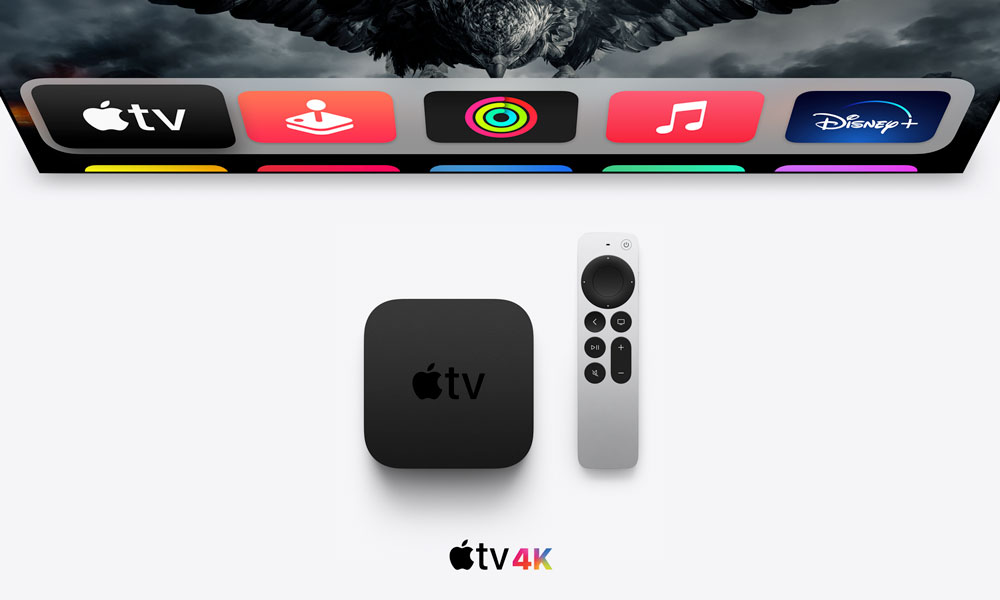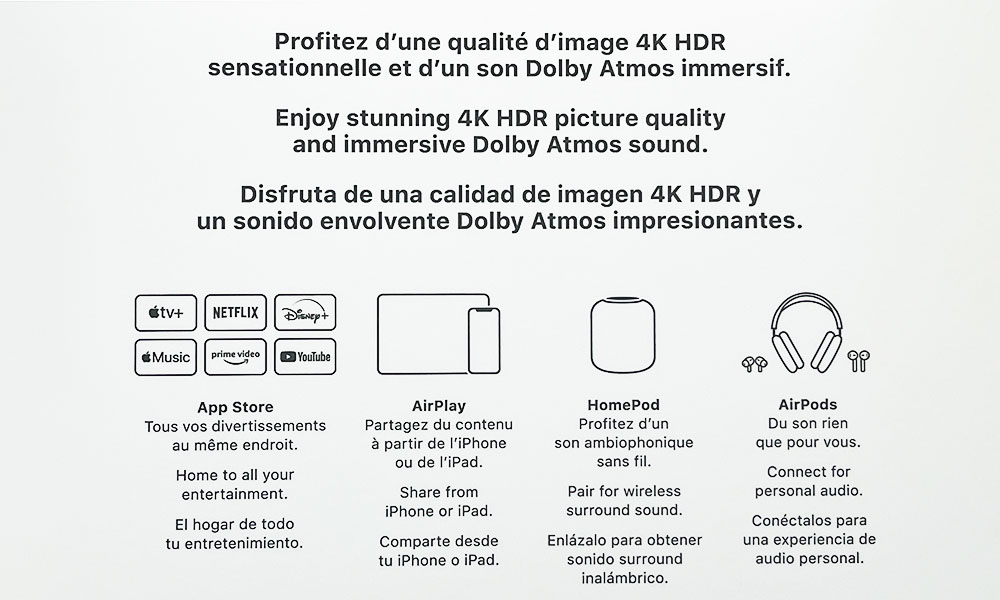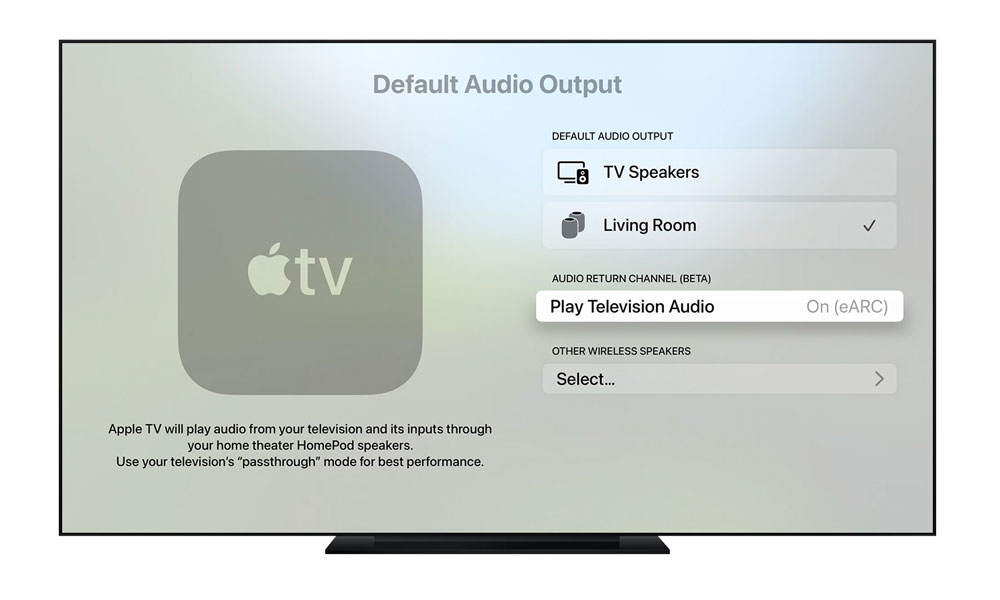The New Apple TV 4K Does Indeed Support ARC (and It’s Pretty Awesome)
 Credit: Apple
Credit: Apple
Toggle Dark Mode
Following the announcement of the 2021 Apple TV 4K last month, evidence appeared in tvOS 14.5 that Apple was working on a new enhancement to allow one or more HomePods to effectively be used to anchor your entire home theatre experience, and now that the new set-top box has arrived in stores, it looks like it’s official.
To be fair, when the reports first appeared that support for eARC has been found in tvOS, it wasn’t entirely clear if this would be coming to the new Apple TV 4K or whether Apple was laying the foundation for some other future Apple TV like product, but now it seems that our best hopes have materialized, as Apple has quietly taken the wraps off the feature in a new support document.
What’s even more astonishing, however, is that Apple is still adding features that are specific to the now-discontinued full-sized HomePod, giving users yet another reason to snap one up before they’re all gone.
Further, right on the back of the box for the new Apple TV 4K is an image of a HomePod — not a HomePod mini, but a full-sized HomePod — with a note that you can “pair for wireless surround sound.”
This leaves us with little doubt that Apple plans to eventually bring out a successor to the full-sized HomePod. For now, however, this new feature is a nice reward for those who have already invested in Apple’s original smart speaker.
How It Works
ARC, which stands for Audio Return Channel, is a long-standing part of the HDMI 1.4 specification, so these days its found in almost all modern TVs, AV receivers, and soundbars. eARC is simply an enhanced version of ARC that’s part of the more recent HDMI 2.1 spec for handling higher-bandwidth audio formats such as Dolby Atmos.
As the name suggests, ARC allows audio to be sent along the same HDMI cable that’s being used to carry a video signal, but in the opposite direction. In other words, while video is being sent TO your TV, audio can be sent back FROM your TV to your receiver or sound bar.
For example, a smart TV with an HDMI ARC port would be able to send audio to your soundbar while watching something directly in an app like Netflix on the smart TV, without the need to use a separate digital audio cable.
What this means for the Apple TV, however, is that for the first time you’ll be able to pass audio INTO your Apple TV from other sources, such as a PlayStation 5 or Blu-ray play.
This is designed to work in tandem with the Home Theatre Audio feature that was introduced in tvOS 14.2 last fall, which allows you to use one or two full-sized HomePods as a Dolby Atmos compatible surround sound system.
While that was a really cool and useful feature to begin with, there was one thing missing that would prevent most people from ditching their AV receiver entirely — it only worked with content played directly from the Apple TV.
Clearly, Apple realized that and has sought to address this limitation by introducing eARC support in the 2021 Apple TV 4K, allowing audio to be fed back from the ARC port on your TV to the Apple TV 4K so that it can then in turn be sent back to your HomePods.
With HDMI ARC or eARC turned on, your Apple TV 4K (2nd generation) can receive high-quality audio from a supported TV and then play that audio through your HomePod speakers.
The result is that a new Apple TV 4K and a pair of HomePods will now be able to work as a full home theatre audio system for most users.
In my case, it’s working exactly as designed with a pair of HomePods, with full surround audio streaming from a PS4 and even an older HD-DVD player, through my TV and Apple TV, straight to my HomePods. I’ve already ripped out my older Denon 7.1 receiver and wired speakers, significantly simplifying my home theatre configuration and cleaning up a whole rat’s nest of wires in the process.
What You’ll Need
Note that the list of requirements to make this work is actually pretty stringent. The HomePod mini is not supported, nor are any of the older Apple TV models. Here’s the specific list of requirements:
- The 2021 Apple TV 4K (2nd generation)
- HomePod speakers (not the HomePod mini)
- A TV that supports HDMI ARC or eARC.
On the new Apple TV 4K, you’ll be able to find the setting under Default Audio Output, although it’s worth noting that Apple has currently labelled it as “Beta,” suggesting that there may still be a few bugs to work out, which will likely happen in future tvOS versions.
In its new support document, Apple also links “HomePod speakers” directly to its “Buy” page, which might lead more cynical folks to see this new feature as a naked attempt to help clear out old HomePod stock. The reality, however, is that the feature works well, and if you want to take advantage of it without waiting to see when (and if) another compatible HomePod comes along, you’re going to need to hurry and pick up an original HomePod before they’re all gone.
To be fair, it’s a bit unclear why the HomePod mini isn’t supported here for at least basic audio. While you obviously won’t get the best home theatre experience with Apple’s smaller speakers, these can be used as audio outputs for the Apple TV.
That said, it’s worth noting that when it comes to Apple TV support, Apple lumps the HomePod mini in the same class as “other AirPlay 2-compatible speakers.” Unlike the full-sized HomePod, you can’t set a HomePod mini as a default audio output — you can only stream to it manually by selecting it in the output options in the same way as any other Bluetooth or AirPlay 2 device.
It appears that the original HomePods get special status because of their ability to work as a true Dolby Atmos home theatre system, and Apple doesn’t want to confuse people by offering a substandard experience. Of course, there may also be other technologies in the full-sized HomePod that’s simply not present in the HomePod mini that affects things like audio synchronization.
You’ll also not only need to make sure that your TV supports either ARC or eARC, but that you’ve connected your Apple TV to the correct HDMI port; many TVs only offer eARC/ARC on a single port. Depending on your manufacturer, you may also need to toggle it on somewhere in your TV settings.








